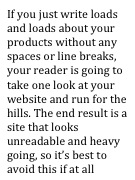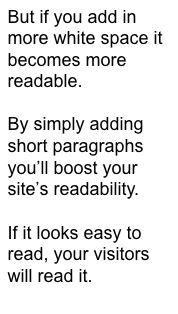Entries from September 2012 ↓
September 17th, 2012 — copywriter, copywriting tips, effective copy
A short while ago I was approached by Joseph Bushnell of Web Marketing Inner Circle, to do an interview about my work as a copywriter.
During the interview Joseph wanted to dig down to find our exactly what it is that makes writing persuasive, powerful and have the ability to sell more. But not only that, he also explored life as a copywriter and what that role involves.
Here are a few of the areas we covered areas such as:
- How to make your web copy more powerful, creative and persuasive
- The essential rule to follow when writing for your own business
- 1 word which you should avoid using in copywriting at all costs (and what word you should use instead)
- 3 tips for making your copy more readable
- How to find out what your customers truly value the most
- Whether you should you focus on one main benefit or multiple benefits?
- How to stop yourself from overwriting
- How to get testimonials that are so strong, they lead to new customers
- 6 ways to get social proof
- 5 newsworthy reasons to publish a press release
- How to create a newsletter that your readers will value (and buy from)
- Whether to use plain text or HTML in your newletters?
- Why you need “thick skin” as a copywriter
- When it might be appropriate to walk away from a copywriting project
You can listen to the interview by clicking on the button below. This will take you to Joseph’s site, to listen click on my mug shot at the bottom of the page.

September 14th, 2012 — copywriting tips, keywords, search engine optimisation, seo, SEO copywriter, seo website copywriter
If you look back through this blog’s archives, you’ll find a number of posts on SEO copywriting such as:
Writing good SEO copy
The importance of off screen SEO
Simple SEO checks any small business can make
But what I want to concentrate on in this post is the use of your keywords.
Going right back to basics, keywords are the words and phrases your customers type in to Google’s search box when looking for your products and services.
In the bad old days, ‘SEO experts’ would have you believe that to be highly ranked, you had to cram as many of those keywords/phrases into your copy.
The result…well, you can imagine; page after page of complete drivel.
Thankfully, those days are gone (but be warned, there are one or two dinosaurs still around touting keyword density as the Holy Gail of SEO copywriting) and marketers are far savvier.
Be natural
Natural writing is the key to good rankings.
By keeping your copy focused on your reader and the benefits you can offer them, your writing will engage and naturally contain your keywords and phrases.
But there is one caveat here: your key phrases do not have to be used in their entirety throughout your web page.
What do I mean by that?
For example, let’s say you sell “designer leather dog collars”, rather than using that phrase in its entirety everywhere in your site, you can break it down using single words such as “designer” and “leather” or combinations “dog collars” “designer leather” “leather collars” etc.
You get the idea.
You see Google looks at your page for synonyms too, so splitting your phrase down will really help your rankings.
Of course, you still need to use it in its entirety somewhere to show Google exactly what your page is about, perhaps in your:
- Headline
- Sub headings
- Alt text
- Anchor text links
Remember, writing SEO copy is an art form when it comes to understanding Google’s likes and dislikes, but the overwhelming aspect of it is to write naturally and always for your reader.
Keep them firmly in your mind when writing your copy. If you start to think about the search engines your content won’t do its job.
September 12th, 2012 — copywriting tips, effective copy
What is the one thing that will get your website visitors buying?
No, I’m not talking about your services or products (although they do help), what I mean are the words on your site.
Pretty images and a flashy high-tech website will only go so far; if the words on your website, or more importantly the way they appear, aren’t clear no one will hang around to buy.
In the past I’ve looked at the importance of your website copy and why it should be full of benefits rather than features, but this post is more concerned with a different aspect of copywriting: the physical writing itself.
Get your message read
In a simple world, someone lands on your website, reads your text, thinks ‘that’s for me’ and buys.
Well, the world isn’t simple and that’s not how it works.
There are several barriers that could stand between you and securing a buying visitor. And I’m not talking about cost or anything like that (although valid barriers), what I mean is the text on your site.
Font size
If someone lands on your site and sees teeny tiny text that they can’t read even with their face presses up against their screen, they’re no going to buy.
But if they’re greeted by a font size that is clear and highly readable, they will continue along the sales process.
Font colour
Black text on a white background is probably the best combination you can have.
White text on a black background isn’t too bad, but can be tricky for some.
But very pale colours on a white background or dark colours on a dark background will be a complete turn off as your reader will have to go and lie down in a darkened room to recover from eye strain.
So think carefully before you decide on your design theme.
Type of font
Your choice of font will also have an impact on the impression you’ll give your visitors.
Most companies opt for something like this font; it’s simple, easy to read and looks professional.
But please, please, please avoid the dreaded Comic Sans font, you may think it shows your playful side, but it doesn’t. It’s just very annoying and makes you look like a. …[you can fill in the blank].
Spacing
The way you lay out your text is also important.


So you see, there’s a lot to think about even before you actually get down to the nuts and bolts of what you’re going to write about.
If you, at all times, have your reader in the forefront of your mind, you won’t go far wrong. Make sure:
• Your text is the right size
• Think carefully about colours and contrasts
• Choose your font wisely
• Keep lots of white space on your page.
September 10th, 2012 — Apps for freelancers, Freelance advice, Running a freelance business
The following guest post was written by Ben Holbrook for all you freelancers out there. The author’s views are entirely his own and may not reflect the views of FreelanceCopywritersBlog.com. If you are interested in producing a Guest Post for this blog, please get in touch with your ideas.
5 Essential Business Travel Apps
For a more efficient working life
In the last few years, smart phones have made it easier than ever to work freelance and/or run a business from anywhere in the world. For those of you looking to maximise your time and energy, here are my  top 5.
top 5.
FlightTrack
It’s more important than ever when travelling on business to be aware of flight delays, gate changes and weather difficulties. FlightTrack gives you all this information and more. Check departure information and detailed satellite maps when your flight is in the air, and find the arrival gate and baggage claim number when you’ve landed.
TripIt
TripIt takes some of the strain out of managing your booking reference numbers by putting them all in one place. Input numbers for flight confirmations, hotel booking and car hire so that you don’t have to carry around lots of bits of paper. Even better, the app will sync to your phone’s calendar, notifying you of important events.
Packing Pro
The most important step of any business trip happens before leaving the house, and that’s packing your bag. Packing Pro lets you plan what to take more efficiently than writing a list by hand. Choose from the vast inventory of items to compile your own list or select one of Packing Pro’s sample templates and modify to suit. Alternatively, input trip details like the weather, number of people and length of stay, and Packing Pro will come up with a list for you.
TripLingo
No app is going to help you master a foreign language in a few hours, but TripLingo provides you with enough phrases to make a good impression. Choose how much time you want to spend learning a language, what you want to learn, and whether you want to be formal or informal. TripLingo will come up with what you need. The app is available in French, Spanish, Japanese and more.
Picksie
After your business meeting, this recommendation app, Picksie, helps you find a spot to unwind with a latte or grab a bite to eat. It’ll looks at your current location, date, search history and past preferences to make recommendations on things to do tailored to your needs. That can be a restaurant, film or event. It’ll even look at the weather, so if it’s raining it won’t suggest an outdoor event.
When Ben isn’t working from the beach you’ll find him writing reviews of the best London hotels for efficient business travel and meetings.
September 7th, 2012 — facebook
Despite the bad press Facebook has been enduring recently after admitting 8.7% of its 955 million active users might not be real and General Motors pulling $10m from its Facebook advertising because of its dissatisfaction with ROI, many businesses are using it as a marketing outlet.
But getting the best from it calls for a bit of creative thinking.
A post on Social Media Examiner caught me eye because it talks about just that.
They spoke with top Facebook experts to find out the hottest marketing tips that businesses today need to know.
Here is a summary of what they said:
1. Leverage videos more effectively
If you sell products or services on your website and have Like buttons attached to them, share videos rather than still images.
2. Experiment with the timings of your postings
You’re probably putting out most of your posts during working hours, but it might be worth experimenting and sending them either early morning, in the evening or at weekends.
Compare results over a period of time and work out when is the best engagement time for you.
3. Be creative with your photos
People love to share photos, so try and come up with new ways of promoting your business through images.
4. Sponsored posts
These will help your content reach more fans. Normally, anything you put out is competing against other businesses to be seen, but using sponsored posts will help boost your reach.
5. Involve your fans
Ask your fans for their input when you’re about to launch a new product.
6. Schedule
Facebook now offer page admins the ability to schedule posts, so you can plan out your messaging and make sure its posted at optimum times.
7. Run contests
A contest will help you engage your fans in a conversation, encourage their friends to join in and collect information from them.
8. Get active
You have to use Facebook personally to understand how it works and what motivates users to interact.
9. Be honest with your resources
Take a look at your business and think about whether you can generate the type of content people will want to share.
You can read the full post and insightful tips from the experts here – 9 Facebook Marketing Tips From Top Experts.










